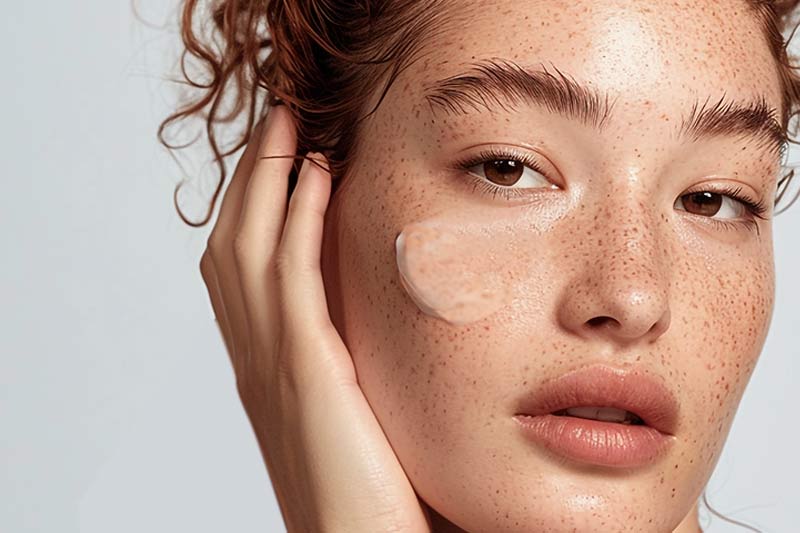The skin contains a complex network of nerve endings that receive stimuli from the outside world and send corresponding signals to the brain. Neurocosmetics is a growing field in skin care that focuses on the communication between the skin and the brain. It surpasses the concept of traditional skin care, introducing ingredients that improve skin health by reducing stress and lifting the mood.
This article lists 10 neurocosmetic ingredients that target the brain-skin axis, reversing aging signs and soothing irritated, dry, and sensitive skin.

10 Neurocosmetics Ingredients to Look for
Many skincare products have a soft texture and enticing smell, producing pleasant sensory experiences. These are not to be confused with neurocosmetics, which are science-based and carefully formulated products that modulate the brain-skin communication pathways. They promote skin health by stimulating the production of feel-good neurotransmitters (e.g., serotonin, dopamine, beta-endorphins, etc.), relaxing muscle contractions, balancing cortisol levels, and providing an overall sense of wellbeing.
The following are some of the neurocosmetic ingredients that have been studied for their effectiveness.
1. Citrus Oils
Citrus oils have anxiolytic, sedative, anti-inflammatory, antioxidant, antibacterial, and astringent properties. By lowering inflammation and stress levels, they help soothe skin irritation, reduce redness, and clear blemishes and imperfections. They are also high in vitamin C, a potent antioxidant and skin brightener.
Neurocosmetic citrus oils include:
- Sweet orange – It has been used for centuries to calm the nerves and improve sleep. It can help shrink pores, reduce blemishes, and improve skin tone.
- Lemon peel oil – Its vapor and pleasant, uplifting smell help balance serotonin and dopamine levels, decreasing anxiety and stress. Lemon peel oil may help reduce acne-causing bacteria (P. acne vulgaris) and skin inflammation, clear clogged pores, and decrease breakouts.
- Mandarin oil – It helps uplift the mood and calm irritated skin.
2. Lemongrass Hydrosol
Lemongrass hydrosol has antifungal, antimicrobial, and antiseptic properties and acts as a natural toner for large pores, blemishes, and lifeless skin. Lemongrass hydrosol also has a refreshing and slightly cooling effect on the nerves. Skin experts recommend it for oily and acne-prone skin.
In many cultures Lemongrass essential oil is often used for its spiritual properties, particularly for clearing the mind, space, and emotions before meditation, prayer, or contemplation. It's also associated with cleansing, purification, and shedding light on hidden issues. Additionally, it's believed to promote openness, clear communication, and the transformation of negative energy into positive.
3. Rosemary Extract
Rosemary leaf has been used throughout history to relieve stress and inflammation. Rosemary leaf extract is a safe, non-toxic, and soothing ingredient with potent antioxidant properties that promote youthful skin. It is also beneficial in treating acne breakouts because of its antimicrobial and astringent effects.
4. Nutmeg Fruit Extract
Nutmeg is a natural adaptogen – an herbal medicine that helps the body adapt to stress. It has a long tradition of use as a stress, anxiety, and fatigue reliever. Nutmeg fruit extract is used in skin care to reduce hyperpigmentation, excess sebum, and redness. It may help fight blemishes and breakouts thanks to its strong antibacterial activity.
5. Vanilla Fruit Extract
Vanilla has an uplifting aroma that stimulates a part of the brain (olfactory), which plays a key role in scent perception and mood regulation. By promoting relaxation and pleasant sensations, it helps reduce inflammation and improve skin conditions. Vanilla fruit extract also has antibacterial and antioxidant effects that may help prevent breakouts.
6. Chamomile
Chamomile is a medicinal plant well known for its calming and healing properties. Chamomile extract and chamomile essential oil used in skin care can help alleviate inflammation, decrease dark spots, tighten enlarged pores, and fight acne-causing bacteria. It promotes relaxation, calms the nerves, and contributes to overall wellbeing.
7. Cucumber Seed Oil
Cucumber seed oil provides vast potential as a neurocosmetic ingredient. It contains antioxidants like linoleic acid and vitamin E, which enhance circulation, stimulate collagen production, help retain moisture, and improve skin barrier function. Its gentle aroma instills a sense of freshness and peace, calming the nerves and soothing inflammatory reactions.
8. Wild Indigo/Neurophroline™
Neurophroline™ is a potent skin-loving ingredient acquired through a specific extraction process from the wild indigo plant. It helps decrease cortisol produced by skin cells, stimulates pain-relieving beta-endorphins, and provides advanced antioxidant and pollution protection. It also has skin-brightening effects, visibly enhancing skin tone and radiance.
9. Monk Fruit/Wonerage™
Wonerage™ is extracted from an Asian plant Tephrosia purpurea. It promotes the synthesis of collagen-producing cells and increases hyaluronic acid production by 320%, helping to firm the skin and reduce wrinkles. It is a powerful ingredient in anti-aging skincare solutions.
10. Neuropeptides
Neuropeptides are Botox-like functional ingredients of natural and synthetic origin. They inhibit the release of acetylcholine, a neurotransmitter that allows muscle contraction, helping to reduce wrinkling. They strengthen the skin’s natural barrier, promote skin elasticity, and help repair aging, dry, dysfunctional, and hyperpigmented skin. They also decrease skin sensitivity to environmental factors.
Examples include:
- Acetyl hexapeptide-3
- Acetyl tripeptide-30 citrulline
- Pentapeptide-18
- Palmitoyl tetrapeptide-7
- Palmitoyl oligopeptide
Neuropeptides don’t penetrate the skin easily, so a cosmetic formulation needs to contain an appropriate delivery system for peptides, such as liposomal and colloidal carriers.
Researchers are studying various ingredients for their neurocosmetic potential, including adaptogens like Rhodiola rosea, soothing botanicals like lavender, algae like Laminaria hyperborea, and many more.
11. Alpine Rose Active
Alpine Rose active is derived from the Rhododendron ferrugineum (Alpine Rose) plant. It is recognized for its ability to modulate skin mediators involved in the stress response, such as serotonin and melatonin. This interaction suggests potential for addressing stress-related skin conditions and improving skin firmness.
12. Kannabia Sense™
The first cosmetic active made from Cannabis sativa plant stem cells, Kannabia Sense™ is designed to stimulate the skin's microbiota, potentially supporting the brain-skin connection and promoting emotional well-being. Kannabia Sense™ has been shown to significantly enhance skin hydration levels, showing an increase of +19% compared to placebo after 28 days of use.
Note: Vibrant is a new skincare line featuring cutting-edge neurocosmetic ingredients paired with microbiome-friendly prebiotics and probiotics for an advanced anti-aging skincare regimen.
Conclusion
Neurocosmetics has opened a new chapter in the cosmetics world and changed our approach to skin care. It fosters the intricate connection between the skin and the brain, emphasizing the importance of healing from within. As a result, neurocosmetic ingredients may be more effective than traditional cosmetics in reversing skin damage and maintaining a healthy, youthful complexion.


